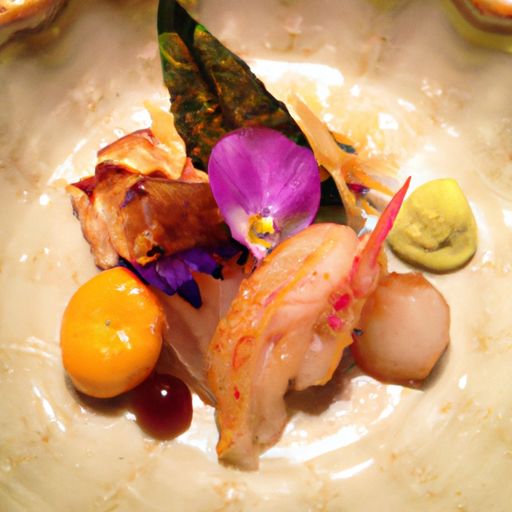Immerse yourself in the rich heritage of Japanese cuisine with Tastepan.com as we take you on a journey to discover the art of Japanese Kaiseki. This traditional multi-course dining experience is known for its elegance and precision, showcasing the delicate flavors and techniques that have been perfected over centuries. From the meticulously prepared dishes to the thoughtful presentation, each course is a work of art that tells a story. Join us as we explore the cultural significance and exquisite flavors of Kaiseki, and deepen your appreciation for the intricate world of Japanese culinary traditions.

History of Kaiseki
Origin of Kaiseki
Kaiseki, a traditional Japanese multi-course meal, originated in the ancient Zen temples of Kyoto during the 16th century. It was predominantly served to accompany tea ceremonies and was initially called “chakaiseki.”
Evolution of Kaiseki
With time, kaiseki progressed from being a ceremonial cuisine to a refined culinary art form. During the Edo period (1603-1868), it became popular among the samurai class as a way to appreciate the changing seasons and nature’s bounty. Gradually, kaiseki spread beyond temple grounds and reached the general population, becoming a symbol of elegance and sophistication.
Influence of Tea Ceremony
The tea ceremony, or “sado,” played a significant role in shaping kaiseki. The principles of harmony, respect, purity, and tranquility practiced in the tea ceremony were integrated into the philosophy and presentation of kaiseki. The art of kaiseki dining became an extension of the tranquility and mindfulness experienced during the tea ceremony.
Philosophy and Principles of Kaiseki
Harmony and Balance
In kaiseki, every aspect is carefully orchestrated to achieve harmony and balance. From the selection and arrangement of ingredients to the progression of flavors, textures, and colors, there is a meticulous balance between each element. This adherence to balance creates a cohesive dining experience where each dish complements the others.
Seasonality
Kaiseki showcases the essence of each season by utilizing seasonal ingredients. The focus on seasonality ensures that diners experience the freshest and most flavorful ingredients at their peak. Each dish reflects the colors and flavors associated with the specific time of year, enhancing the overall sensory experience.
Simplicity and Minimalism
Kaiseki embodies the concept of “less is more.” It emphasizes simplicity and minimalism both in presentation and preparation. The beauty of the natural ingredients takes center stage, and excessive garnishing or complicated techniques are avoided. The emphasis lies on preserving the purity of flavors and allowing the ingredients to speak for themselves.

Key Components of Kaiseki
Dashimaki (Appetizer)
The kaiseki meal begins with a dashimaki, a small appetizer that stimulates the appetite and sets the stage for the subsequent courses. The dashimaki is thoughtfully crafted to showcase flavors, textures, and colors that harmonize with the overall progression of the meal.
Hassun (Second Course)
Following the dashimaki, the hassun course is served, presenting a variety of small seasonal dishes on a single plate or platter. The hassun highlights the chef’s creativity and skill, often incorporating ingredients from the local area or inspired by traditional symbolism. It is a visual and gastronomic representation of the changing seasons.
Mukozuke (Sashimi Course)
The mukozuke course features the freshest sashimi, thinly sliced raw fish or seafood, carefully selected by the chef. The sashimi is served with minimal seasoning, allowing the natural flavors of the ingredients to shine. The mukozuke course showcases the chef’s expertise in sourcing the highest quality seafood and highlights the delicate balance between textures and flavors.
Kaiseki Restaurant Atmosphere
Tea Room Aesthetics
Kaiseki restaurants often emulate the serene atmosphere of traditional tea rooms. The calming decor, use of natural materials, and subdued lighting create a sense of tranquility. The interior design is minimalistic, allowing diners to focus on the culinary experience and appreciate the artistry of each dish.
Traditional Table Settings
Kaiseki meals are typically served on low tables called “chabudai,” where diners sit on floor cushions known as “zabuton.” The table setting includes elegant ceramic and lacquerware, with each piece carefully chosen to reflect the aesthetic and seasonality of the meal. The attention to detail extends to the placement of chopsticks, napkins, and even the orientation of dishes.
Interaction with the Chef
The kaiseki dining experience often involves direct interaction with the chef. Many restaurants feature open kitchens or counter-style seating where diners can witness the meticulous preparation and plating of each course. The chef may also engage in conversation, providing insights into the ingredients, techniques, and inspiration behind the dishes.

Kaiseki Ingredients
Fresh and Local Ingredients
Kaiseki cuisine places great emphasis on utilizing fresh, seasonal, and locally sourced ingredients. The chefs carefully select produce, seafood, and meats that are at their peak of flavor. This commitment to freshness ensures the highest quality and allows diners to savor the unique flavors of each ingredient.
Umami-rich Flavors
Umami, often described as the fifth taste, plays a significant role in kaiseki. The use of ingredients such as seaweed, mushrooms, soy sauce, and fermented foods adds depth and richness to the dishes. Umami enhances the overall taste experience, creating a balance between sweetness, sourness, bitterness, and saltiness.
Seasonal Produce
The changing seasons heavily influence the selection of ingredients in kaiseki cuisine. Chefs work closely with local farmers and suppliers to incorporate the freshest and most diverse range of seasonal produce. By embracing seasonal ingredients, kaiseki celebrates the flavors and colors that define each time of year.
Kaiseki Cooking Techniques
Grilling (Yakimono)
Grilling, or “yakimono,” is a popular cooking technique in kaiseki. It involves cooking ingredients over an open flame or charcoal grill to enhance their natural flavors. The smoky aromas and caramelization that result from grilling add depth and complexity to the dishes, creating a delightful sensory experience.
Steaming (Mushimono)
Steaming, or “mushimono,” is a gentle cooking technique used in kaiseki to preserve the delicate flavors and textures of ingredients. Steaming allows the natural sweetness of vegetables, fish, and tofu to shine through, resulting in tender and moist dishes. This technique also ensures that the nutrients and essence of the ingredients are retained.
Simmering (Nimono)
Simmering, or “nimono,” is a slow-cooking method that infuses flavors into ingredients. In kaiseki, simmering is used to create rich broths, tender braised meats, and vegetable dishes with a depth of flavor. The slow cooking process allows the ingredients to absorb the aromas and essences, resulting in dishes that are comforting and full of umami.
Serving and Presentation in Kaiseki
Artistic Arrangement
Presentation is paramount in kaiseki, and each dish is meticulously arranged to create a visually stunning experience. The chef considers the color, shape, and texture of each ingredient, carefully arranging them on the plate. The goal is to create a masterpiece that not only delights the taste buds but also captures the essence of the dish.
Ceramic Ware and Tableware
Kaiseki dining often showcases traditional ceramic ware and tableware made by skilled artisans. Each piece is selected to complement the dish it holds, creating a harmonious aesthetic. The beauty of the ceramics adds an extra element of elegance to the dining experience, further enhancing the appreciation of the culinary masterpiece.
Edible Garnishes
Kaiseki chefs use edible garnishes to enhance the visual appeal of their dishes. Delicate flowers, thinly sliced vegetables, and intricately carved garnishes are added to create a feast for the eyes as well as the palate. These artful decorations reflect the changing seasons, adding an extra layer of beauty to the dining experience.
Kaiseki Seasonal Themes
Spring (Haru)
Spring-themed kaiseki menus are characterized by vibrant colors and fresh flavors. Dishes often feature ingredients such as cherry blossoms, young bamboo shoots, and tender spring vegetables. The menu celebrates the revival of nature, with a focus on light and refreshing flavors that reflect the new beginnings of the season.
Summer (Natsu)
Kaiseki menus for summer highlight the refreshing and cooling elements of ingredients. Dishes may incorporate chilled soups, seafood, and seasonal fruits. The emphasis is on dishes that provide respite from the heat, offering a balance between light and nourishing flavors. Summer kaiseki menus often use ingredients like watermelon, cucumber, and eel.
Autumn (Aki)
Autumn-themed kaiseki menus showcase the rich and earthy flavors associated with the season. Ingredients such as mushrooms, chestnuts, and hearty vegetables are featured prominently. The menu expresses the transition from the vibrant colors of summer to the warm hues of autumn, offering a taste of comfort and nostalgia.
Kaiseki Menu Styles
Shojin Kaiseki (Vegetarian)
Shojin kaiseki is a vegetarian style of kaiseki that originated in Zen Buddhist temples. It follows the principle of non-violence and focuses on using plant-based ingredients. Shojin kaiseki centers on simplicity, balance, and respect for nature. The menu typically includes a wide variety of vegetables, tofu, and seasonal mountain produce.
Cha-Kaiseki (Tea Ceremony)
Cha-kaiseki is a specialized style of kaiseki that is served before or after the formal tea ceremony. The menu is meticulously designed to harmonize with the tea being served. Cha-kaiseki often consists of small, seasonal courses, with delicate flavors and textures that enhance the tea ceremony experience. The emphasis is on creating a seamless union of food and tea.
Modern Interpretations
While traditional kaiseki remains the pinnacle of culinary artistry, modern interpretations have emerged that incorporate new ingredients, techniques, and creative presentations. These innovative approaches still adhere to the core principles of kaiseki while embracing contemporary flavors and influences. Modern kaiseki allows chefs to showcase their creativity and reimagine the traditional multi-course dining experience.
Etiquette and Customs in Kaiseki Dining
Proper Use of Chopsticks
When dining in a kaiseki restaurant, it is important to handle chopsticks with proper etiquette. Avoid using chopsticks to stab or pierce food. Instead, use them to pick up bite-sized portions. It is also considered disrespectful to pass food directly from chopsticks to chopsticks, as this resembles a funeral ritual.
Tea Drinking Etiquette
In kaiseki dining, tea often accompanies the meal. Proper tea drinking etiquette involves holding the tea cup with both hands when receiving it and taking a moment to express gratitude before taking a sip. It is customary to finish the tea before moving on to the next course. Tasting the tea mindfully enhances the overall dining experience.
Silent Appreciation
Kaiseki dining is often characterized by a quiet and contemplative atmosphere. It is customary to maintain a sense of silence and show appreciation for the culinary artistry. While discussions between diners are welcome, it is important to keep voices low and avoid disruptive behavior that may disturb the tranquil ambiance and disrupt the dining experience.
In conclusion, kaiseki is not just a meal but a sensory journey that celebrates the essence of Japanese culinary art. The history, philosophy, and customs surrounding kaiseki highlight the deep-rooted appreciation for nature, seasonality, and the delicate balance of flavors and aesthetics. With its rich heritage and meticulous attention to detail, kaiseki continues to captivate diners, offering an unforgettable and elegant dining experience.

